Establishment and Preliminary Application of the Forward Modeling Method for Doppler Spectral Density of Ice Particles
Abstract
1. Introduction
2. Data and Methods
2.1. Data
2.1.1. Cloud Radar
2.1.2. Aircraft Instruments
2.2. Methods
2.2.1. Determination of the Shape of Ice Particles
2.2.2. Fall Velocities
- The modified best number can be calculated as when the values of , , , , and D are given. Here, is the dynamic viscosity of air, is the density of air, m is mass, and g is gravity. is defined as the particle’s area ratio, i.e., the ratio of projected area (A) to the particle’s circumscribed circle area. The m- and A–D relations are obtained using the formula compiled by Mitchell (1996), and the coefficients used are given in Table 2. Here, D is the particle’s maximum dimension (the diameter of the circumscribed circle of the particle).
- Then, the Reynolds number is estimated as using = 0.35 and = 8.0.
- Finally, particle fall velocity is directly computed as .
2.2.3. Backscattering Cross-Section
3. Results
3.1. Analysis and Simulation
3.1.1. Fall Velocities and Backscattering Cross-Section of Different Types of Ice Particles
3.1.2. Doppler Spectral Density and PSD Retrieval Simulations
3.2. Retrieved Ressults from MMCR
3.3. Comparison with Aircraft Detection
4. Conclusions and Discussion
Author Contributions
Funding
Conflicts of Interest
Abbreviations
| a | half-width of columnar crystals |
| A | projected area |
| area ratio (the ratio of projected area to the particle’s circumscribed circle area) | |
| maximum diameter | |
| equivalent ice sphere diameter | |
| volume-weighted diameter | |
| g | gravity |
| air speed | |
| fall velocity | |
| radial velocity detected by radar | |
| equivalent reflectivity | |
| Doppler spectral density | |
| number of particles per unit volume per unit | |
| and | backscattering cross section |
| complex permittivity | |
| wavelength | |
| ice density | |
| L | length of ice crystals |
| dynamic viscosity of air | |
| air density | |
| mass | |
| Reynolds number | |
| modified best number | |
| area of ice crystals intersected by the plane | |
| k | wave number |
| kurtosis parameter | |
| prefactor of the power law computed by | |
| intercept parameter of exponential function | |
| shape parameter of exponential function | |
| Doppler spectral density affected by turbulence | |
| intensity of turbulence |
References
- Rosenfeld, D.; Lohmann, U.; Raga, G.B.; O’Dowd, C.D.; Kulmala, M.; Fuzzi, S.; Reissell, A.; Andreae, M.O. Flood or Drought: How Do Aerosols Affect Precipitation? Science 2008, 321, 1309–1313. [Google Scholar] [CrossRef] [PubMed]
- Yu, H.; Kaufman, Y.J.; Chin, M.; Feingold, G.; Remer, L.A.; Anderson, T.L.; Balkanski, Y.; Bellouin, N.; Boucher, O.; Christopher, S.; et al. A review of measurement-based assessments of the aerosol direct radiative effect and forcing. Atmos. Chem. Phys. 2006, 6, 666. [Google Scholar] [CrossRef]
- Chakraborty, S.; Fu, R.; Massie, S.T.; Stephens, G. Relative influence of meteorological conditions and aerosols on the lifetime of mesoscale convective systems. Proc. Natl. Acad. Sci. USA 2016, 113, 7426–7431. [Google Scholar] [CrossRef]
- Field, P.R.; Heymsfield, A.J. Importance of snow to global precipitation. Geophys. Res. Lett. 2015, 42, 9512–9520. [Google Scholar] [CrossRef]
- Kollias, P.; Albrecht, B.A.; Lhermitte, R.; Savtchenko, A. Radar Observations of Updrafts, Downdrafts, and Turbulence in Fair-Weather Cumuli. J. Atmos. Sci. 2001, 58, 1750–1766. [Google Scholar] [CrossRef]
- Gossard, E.E. Measurement of Cloud Droplet Size Spectra by Doppler Radar. J. Atmos. Ocean. Technol. 1994, 11, 712–726. [Google Scholar] [CrossRef]
- Liu, L.; Xie, L.; Cui, Z. Examination and application of Doppler spectral density data in drop size distribution retrieval in weak precipitation by cloud radar. Chin. J. Atmos. Sci. 2014, 38, 223–236. (In Chinese) [Google Scholar] [CrossRef]
- Kollias, P.; Rémillard, J.; Luke, E.; Szyrmer, W. Cloud radar Doppler spectra in drizzling stratiform clouds: 1. Forward modeling and remote sensing applications. J. Geophys. Res. Atmos. 2011, 116. [Google Scholar] [CrossRef]
- Gossard, E.E.; Snider, J.B.; Clothiaux, E.E.; Martner, B.; Gibson, J.S.; Kropfli, R.A.; Frisch, A.S. The Potential of 8-mm Radars for Remotely Sensing Cloud Drop Size Distributions. J. Atmos. Ocean. Technol. 1997, 14, 76–87. [Google Scholar] [CrossRef]
- Yang, P.; Liou, K.-N.; Bi, L.; Liu, C.; Yi, B.; Baum, B.A. On the radiative properties of ice clouds: Light scattering, remote sensing, and radiation parameterization. Adv. Atmos. Sci. 2015, 32, 32–63. [Google Scholar] [CrossRef]
- Liu, G. A Database of Microwave Single-Scattering Properties for Nonspherical Ice Particles. Bull. Am. Meteorol. Soc. 2008, 89, 1563–1570. [Google Scholar] [CrossRef]
- Zhao, C.; Liu, L.; Wang, Q.; Qiu, Y.; Wang, W.; Wang, Y.; Fan, T. Toward Understanding the Properties of High Ice Clouds at the Naqu Site on the Tibetan Plateau Using Ground-Based Active Remote Sensing Measurements Obtained during a Short Period in July 2014. J. Appl. Meteorol. Climatol. 2016, 55, 2493–2507. [Google Scholar] [CrossRef]
- Protat, A.; Delanoë, J.; Bouniol, D.; Heymsfield, A.J.; Bansemer, A.; Brown, P. Evaluation of Ice Water Content Retrievals from Cloud Radar Reflectivity and Temperature Using a Large Airborne In Situ Microphysical Database. J. Appl. Meteorol. Climatol. 2007, 46, 557–572. [Google Scholar] [CrossRef]
- Sassen, K.; Wang, Z.; Khvorostyanov, V.I.; Stephens, G.L.; Bennedetti, A. Cirrus cloud ice water content radar algorithm evaluation using an explicit cloud microphysical model. J. Appl. Meteorol. 2002, 41, 620–628. [Google Scholar] [CrossRef]
- Mace, G.G.; Heymsfield, A.J.; Poellot, M.R. On retrieving the microphysical properties of cirrus clouds using the moments of the millimeter-wavelength Doppler spectrum. J. Geophys. Res. Atmos. 2002, 107, AAC 22-21–AAC 22-26. [Google Scholar] [CrossRef]
- Zhong, L.; Liu, L.; Deng, M.; Zhou, X. Retrieving microphysical properties and air motion of cirrus clouds based on the doppler moments method using cloud radar. Adv. Atmos. Sci. 2012, 29, 611–622. [Google Scholar] [CrossRef]
- Liu, L.; Ding, H.; Dong, X.; Cao, J.; Su, T. Applications of QC and Merged Doppler Spectral Density Data from Ka-Band Cloud Radar to Microphysics Retrieval and Comparison with Airplane in Situ Observation. Remote Sens. 2019, 11, 1595. [Google Scholar] [CrossRef]
- Barrett, A.I.; Westbrook, C.D.; Nicol, J.C.; Stein, T.H. Rapid ice aggregation process revealed through triple-wavelength Doppler spectrum radar analysis. Atmos. Chem. Phys. 2019, 19, 5753–5769. [Google Scholar] [CrossRef]
- Kneifel, S.; Kollias, P.; Battaglia, A.; Leinonen, J.; Maahn, M.; Kalesse, H.; Tridon, F. First observations of triple-frequency radar Doppler spectra in snowfall: Interpretation and applications. Geophys. Res. Lett. 2016, 43, 2225–2233. [Google Scholar] [CrossRef]
- Magono, C.; Lee, C.W. Meteorological classification of natural snow crystals. J. Fac. Sci. Hokkaido Univ. Ser. 7 Geophys. 1966, 2, 321–335. [Google Scholar]
- Bailey, M.P.; Hallett, J. A comprehensive habit diagram for atmospheric ice crystals: Confirmation from the laboratory, AIRS II, and other field studies. J. Atmos. Sci. 2009, 66, 2888–2899. [Google Scholar] [CrossRef]
- Auer, A.H., Jr.; Veal, D.L. The dimension of ice crystals in natural clouds. J. Atmos. Sci. 1970, 27, 919–926. [Google Scholar] [CrossRef]
- Mitchell, D.L.; Arontt, W.P. A model predicting the evolution of ice particle size spectra and radiative properties of cirrus clouds.Part II: Dependence of absorption and extinction on ice crystal morphology. J. Atmos. Sci. 1994, 51, 817–832. [Google Scholar] [CrossRef]
- Hogan, R.J.; Westbrook, C.D. Equation for the microwave backscatter cross section of aggregate snowflakes using the self-similar Rayleigh–Gans approximation. J. Atmos. Sci. 2014, 71, 3292–3301. [Google Scholar] [CrossRef][Green Version]
- Matrosov, S.Y.; Heymsfield, A.J. Use of Doppler radar to assess ice cloud particle fall velocity-size relations for remote sensing and climate studies. J. Geophys. Res. Atmos. 2000, 105, 22427–22436. [Google Scholar] [CrossRef]
- Mitchell, D.L.; Heymsfield, A.J. Refinements in the treatment of ice particle terminal velocities, highlighting aggregates. J. Atmos. Sci. 2005, 62, 1637–1644. [Google Scholar] [CrossRef]
- Khvorostyanov, V.I.; Curry, J.A. Fall velocities of hydrometeors in the atmosphere: Refinements to a continuous analytical power law. J. Atmos. Sci. 2005, 62, 4343–4357. [Google Scholar] [CrossRef]
- Khvorostyanov, V.I.; Curry, J.A. Terminal velocities of droplets and crystals: Power laws with continuous parameters over the size spectrum. J. Atmos. Sci. 2002, 59, 1872–1884. [Google Scholar] [CrossRef]
- Mitchell, D.L. Use of mass- and area-dimensional power laws for determining precipitation particle terminal velocities. J. Atmos. Sci. 1996, 53, 1710–1723. [Google Scholar] [CrossRef]
- Heymsfield, A.J.; Westbrook, C.D. Advances in the Estimation of Ice Particle Fall Speeds Using Laboratory and Field Measurements. J. Atmos. Sci. 2010, 67, 2469–2482. [Google Scholar] [CrossRef]
- Mie, G. Beiträge zur Optik trüber Medien, speziell kolloidaler Metallösungen. Ann. Der Phys. 1908, 330, 377–445. [Google Scholar] [CrossRef]
- Macke, A.; Mueller, J.; Raschke, E. Single Scattering Properties of Atmospheric Ice Crystals. J. Atmos. Sci. 1996, 53, 2813–2825. [Google Scholar] [CrossRef]
- Craig, F.B.; Bohren, F.; Huffman, D. Absorption and Scattering of Light by Small Particles; John Wiley & Sons Inc.: New York, NY, USA, 1983. [Google Scholar]
- Heymsfield, A.J.; Platt, C.M.R. A parameterization of the particle size spectrum of ice clouds in terms of the ambient temperature and the ice water content. J. Atmos. Sci. 1984, 41, 846–855. [Google Scholar] [CrossRef]
- Ryan, B.F. A bulk parameterization of the ice particle size distribution and the optical properties in ice clouds. J. Atmos. Sci. 2000, 57, 1436–1451. [Google Scholar] [CrossRef]
- Gunn, K.; Marshall, J. The distribution with size of aggregate snowflakes. J. Meteorol. 1958, 15, 452–461. [Google Scholar] [CrossRef]
- Platt, C.M.R. A parameterization of the visible extinction coefficient of ice clouds in terms of the ice/water content. J. Atmos. Sci. 1997, 54, 2083–2098. [Google Scholar] [CrossRef]
- Zhenhui, W.; Xu, T. A study of the relationship between the attenuation coefficient and radar reflectivity factor for spherical particles in clouds at millimeter wavelengths. Acta Meteorol. Sin. 2011, 69, 1020–1028. [Google Scholar]
- Barber, P.; Yeh, C. Scattering of electromagnetic waves by arbitrarily shaped dielectric bodies. Appl. Opt. 1975, 14, 2864–2872. [Google Scholar] [CrossRef]
- Liao, L.; Sassen, K. Investigation of relationships between Ka-band radar reflectivity and ice and liquid water contents. Atmos. Res. 1994, 34, 231–248. [Google Scholar] [CrossRef]
- Atlas, D.; Matrosov, S.Y.; Heymsfield, A.J.; Chou, M.-D.; Wolff, D.B. Radar and radiation properties of ice clouds. J. Appl. Meteorol. 1995, 34, 2329–2345. [Google Scholar] [CrossRef]
- Liu, C.-L.; Illingworth, A.J. Toward more accurate retrievals of ice water content from radar measurements of clouds. J. Appl. Meteorol. 2000, 39, 1130–1146. [Google Scholar] [CrossRef]
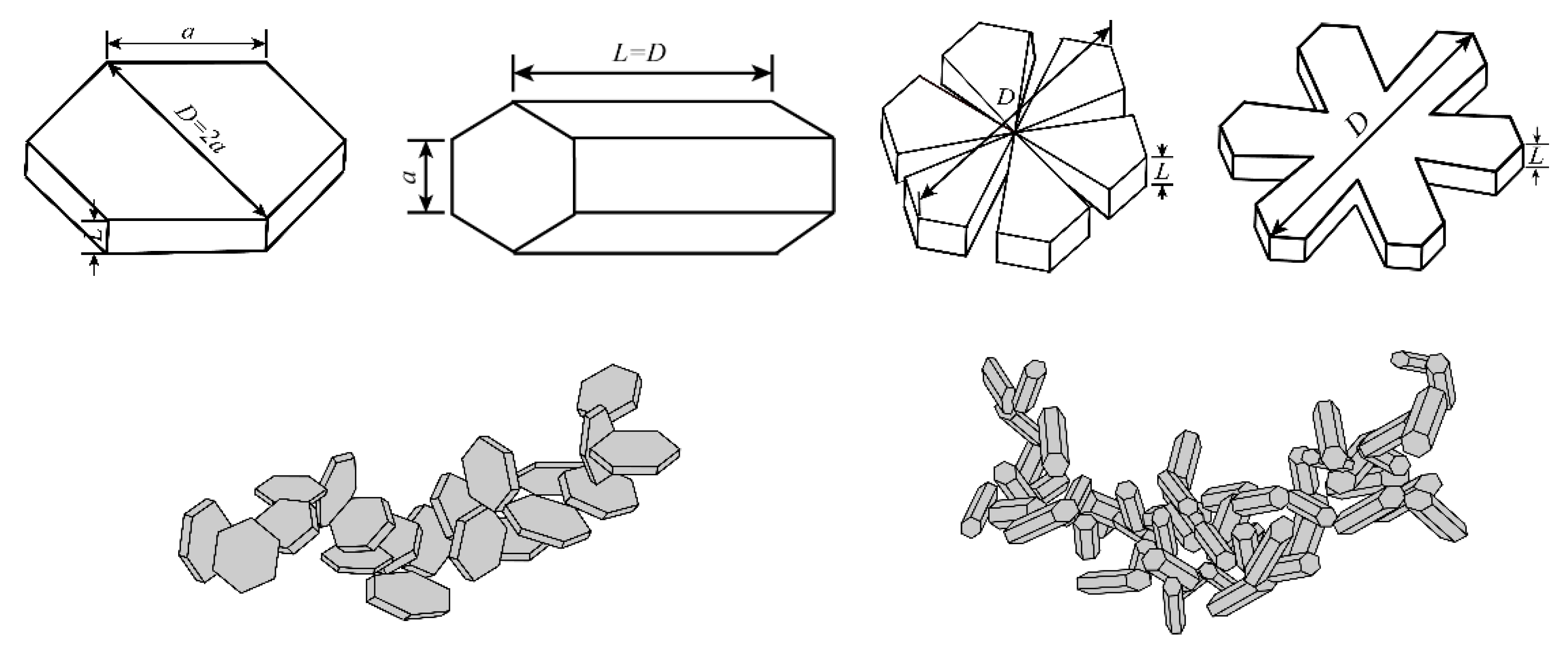
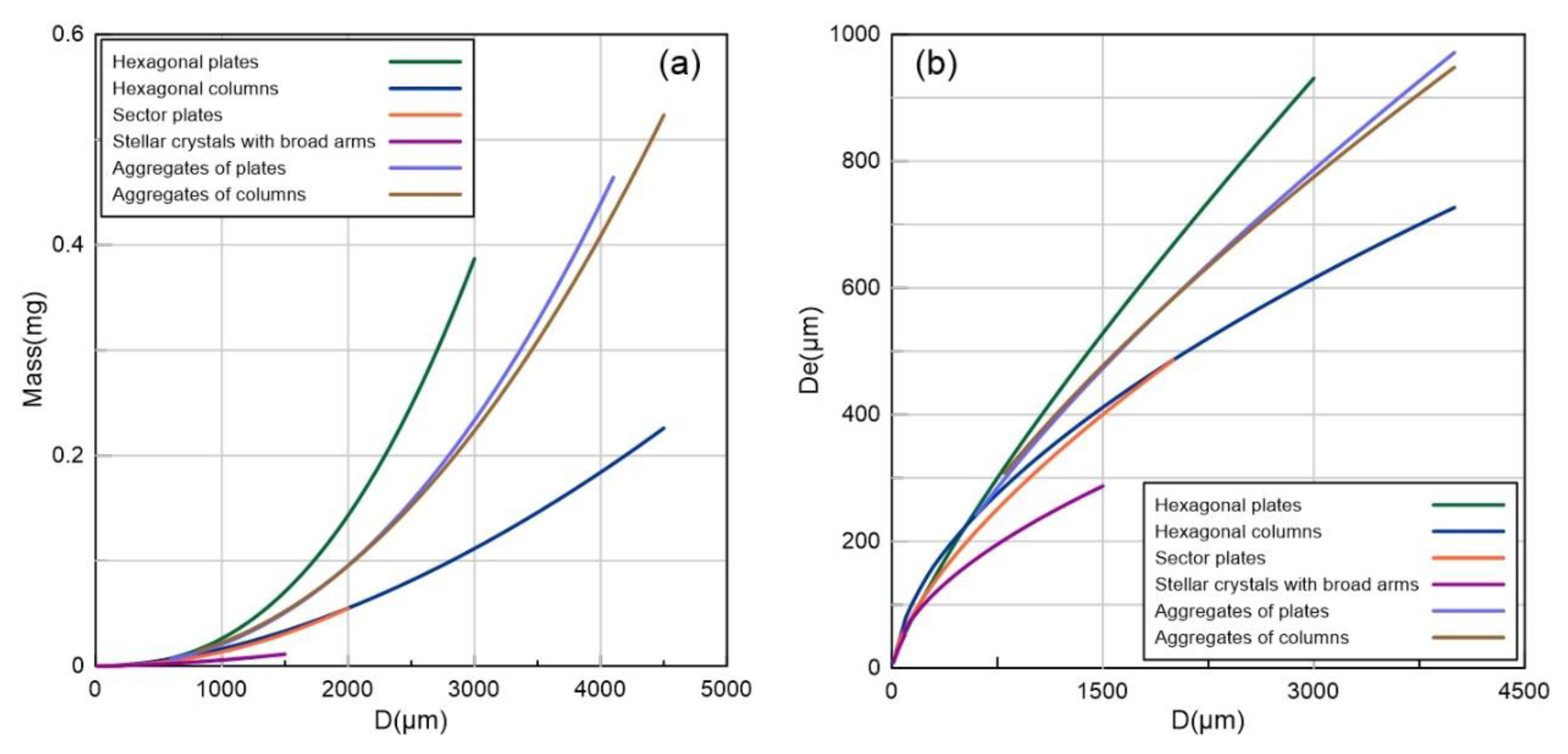
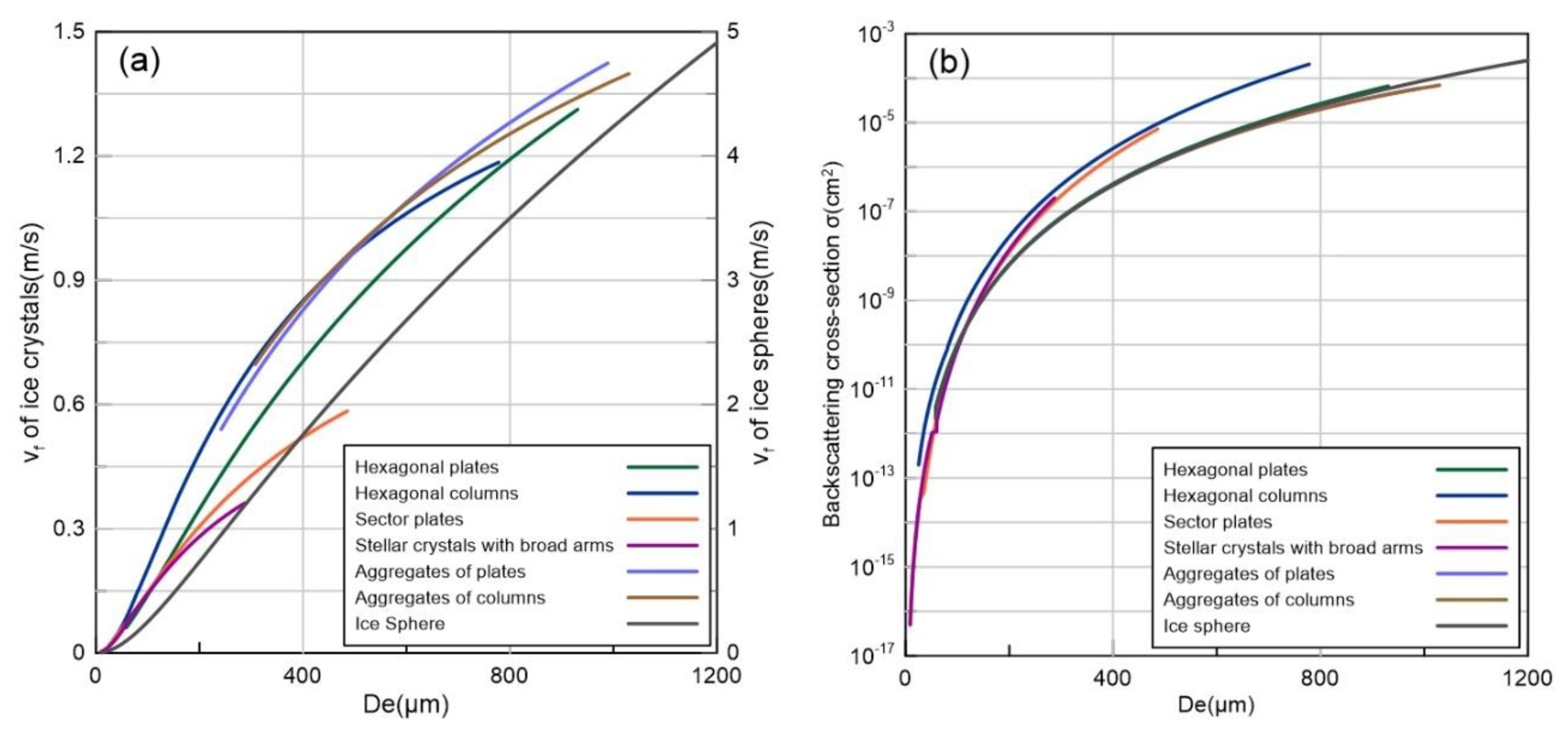
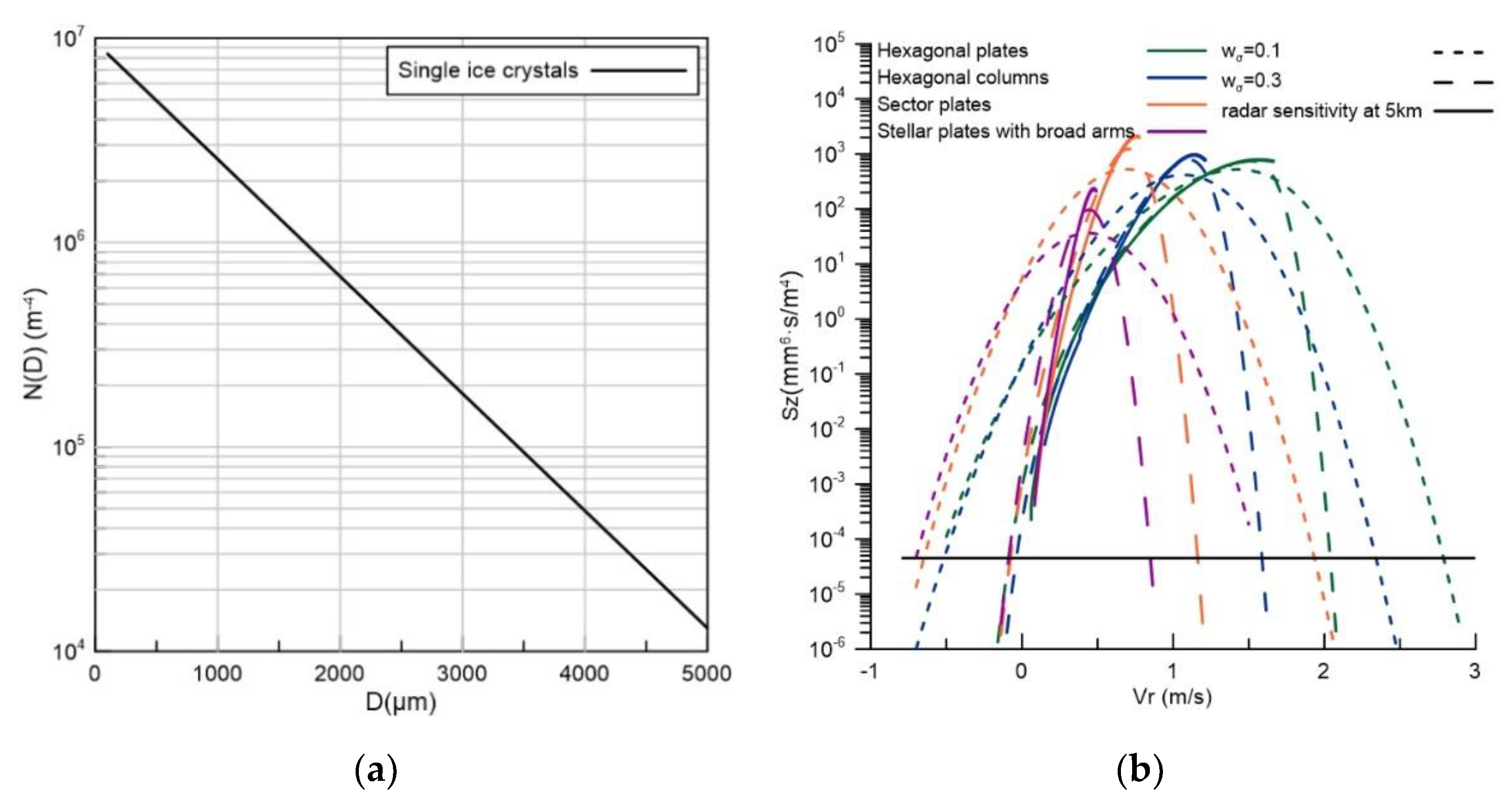
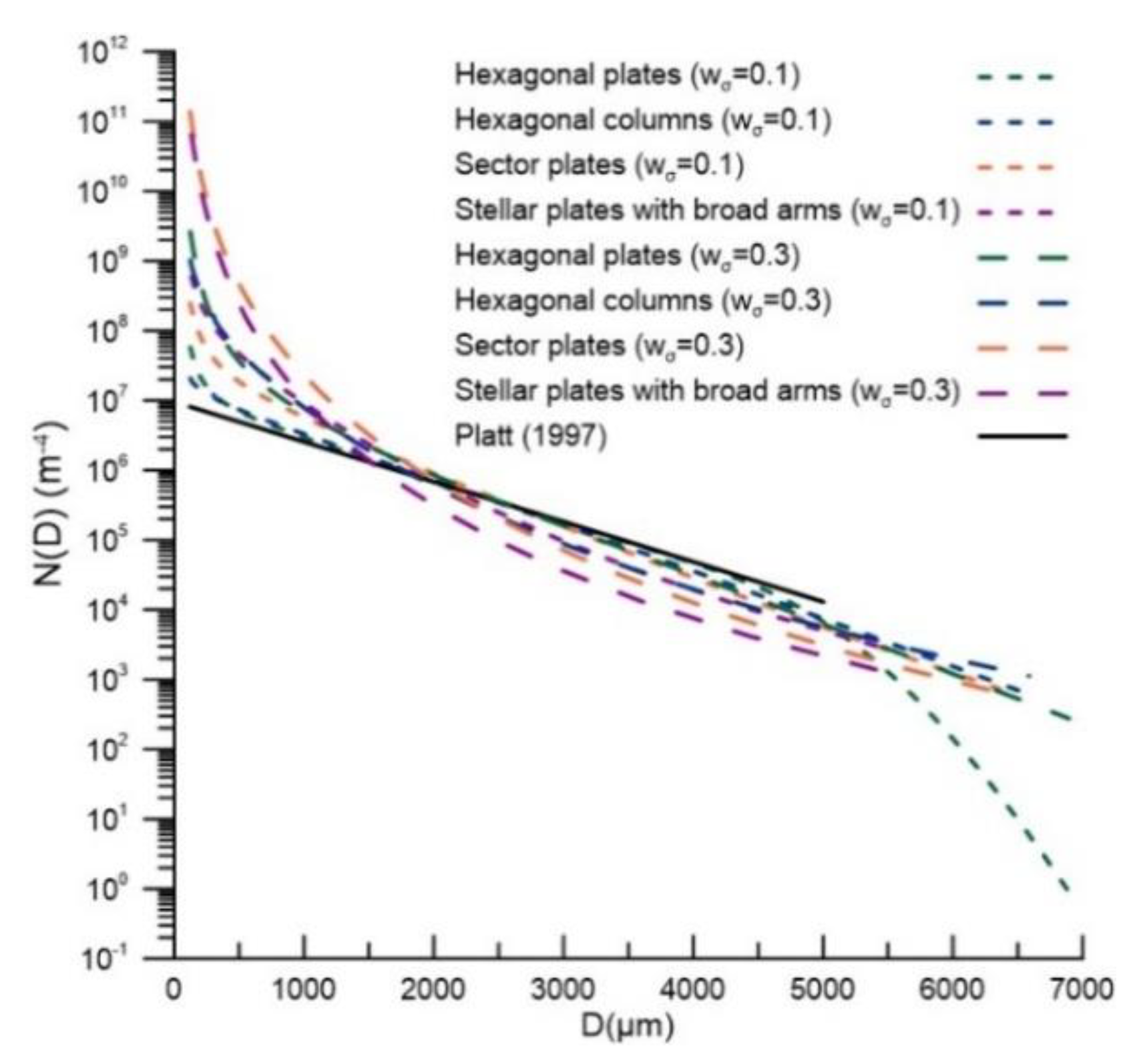
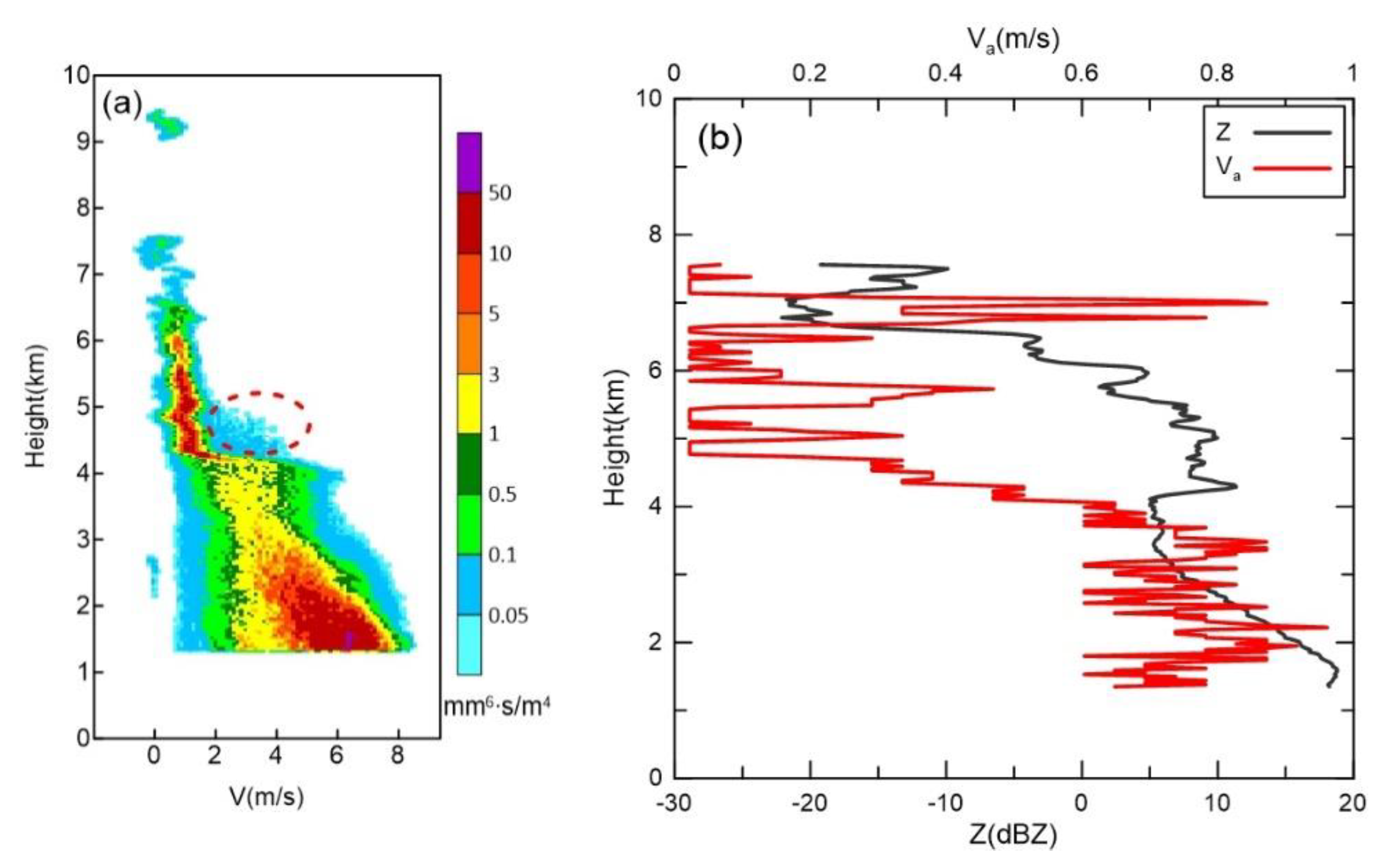
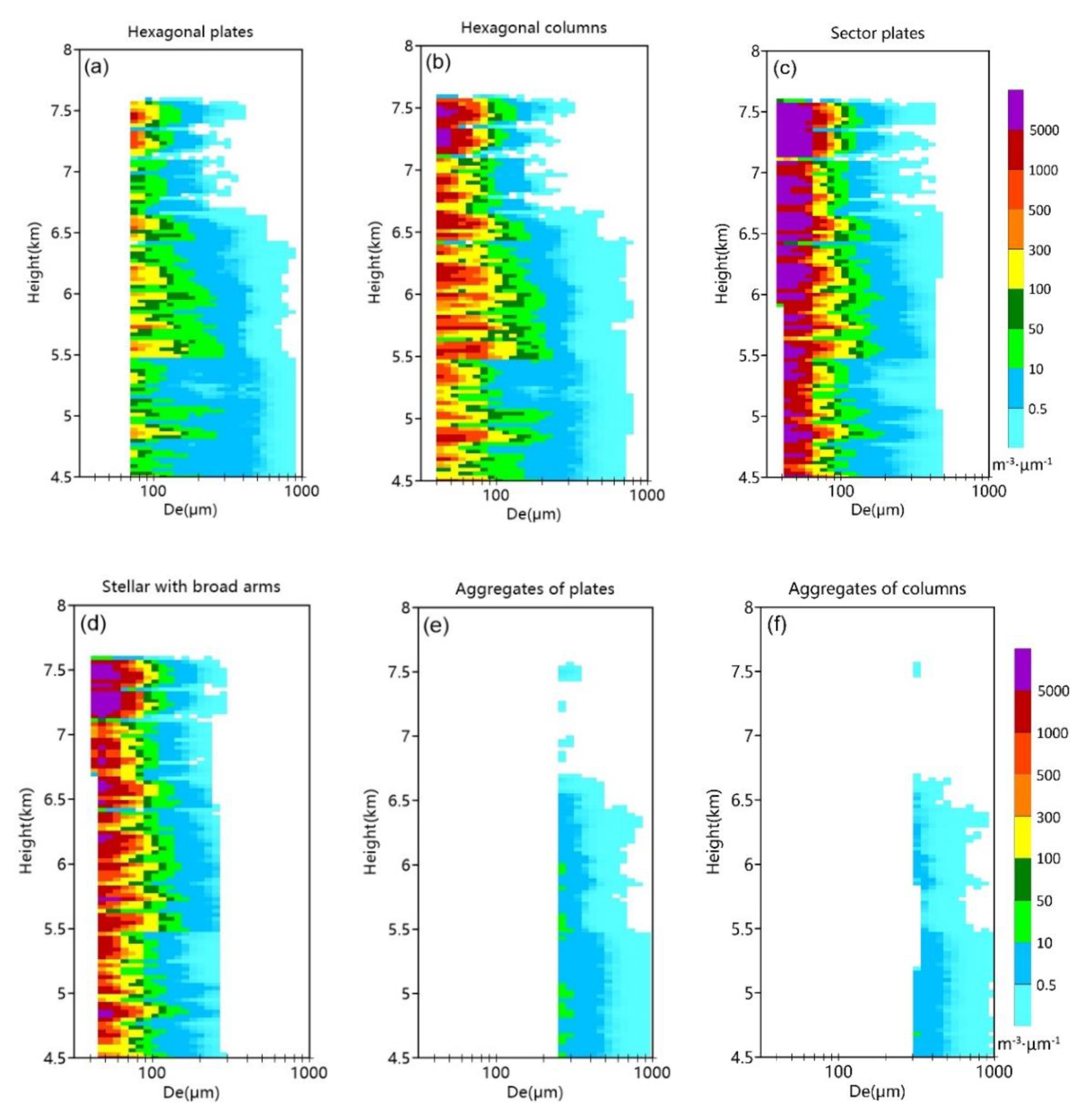
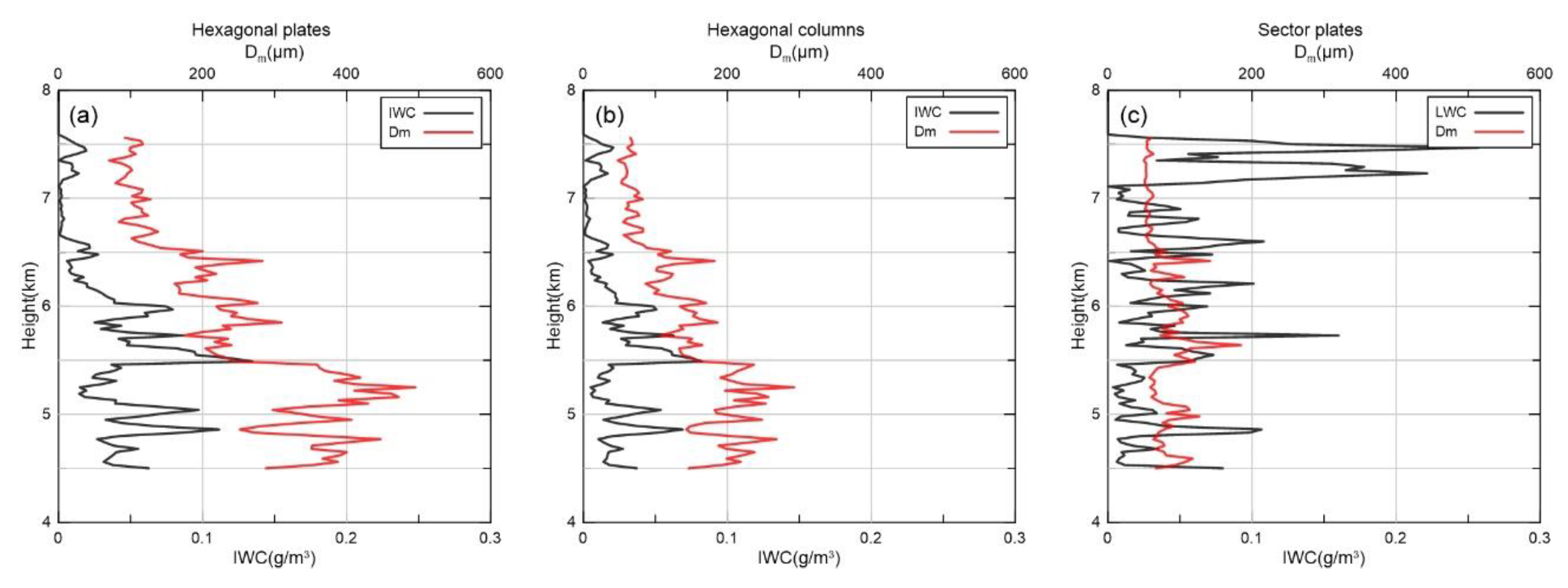

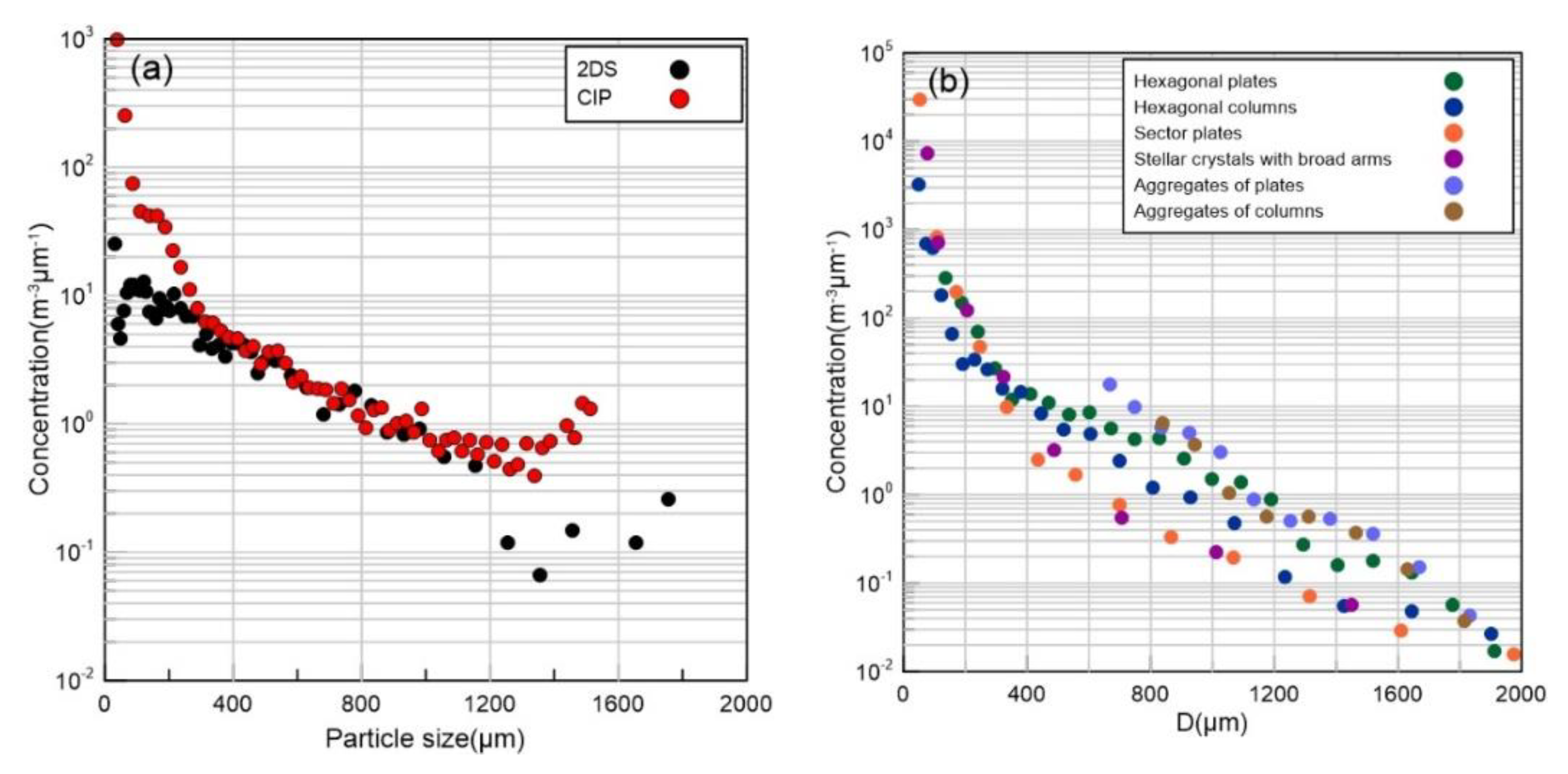
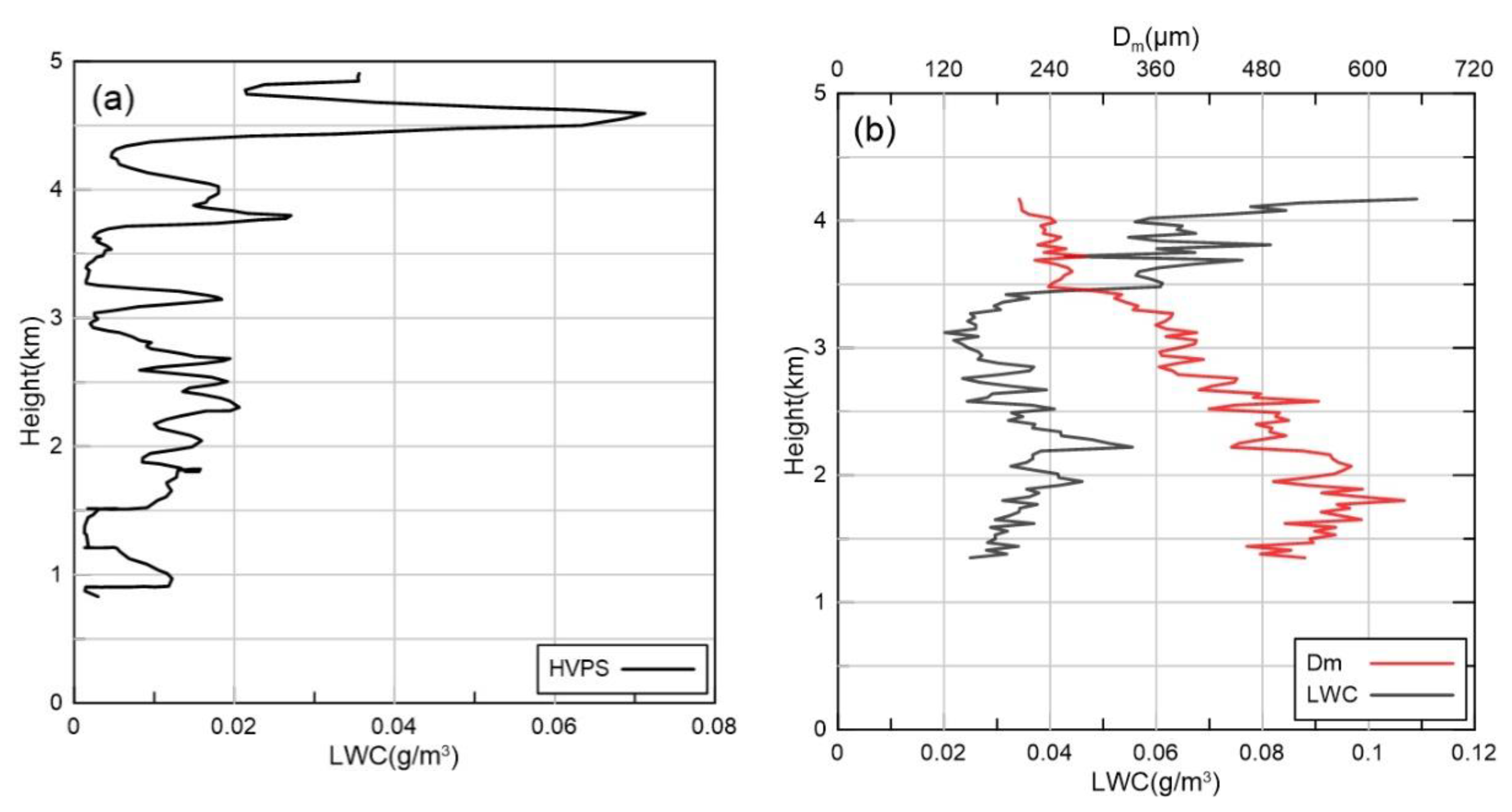

| Item | Precipitation Mode (M1) | Boundary Mode (M2) | Middle Level Mode (M3) | Cirrus Mode (M4) |
|---|---|---|---|---|
| Pulse width | 0.2 μs | 2 μs | 8 μs | 20 μs |
| Pulse repetition frequency | 8000 Hz | 8000 Hz | 8000 Hz | 8000 Hz |
| Number of coherent integrations | 1 | 3 | 3 | 4 |
| Number of incoherent integrations | 4 | 4 | 4 | 4 |
| Number of fast Fourier transforms | 256 | 256 | 256 | 256 |
| Dwell time | 4 s | 4 s | 4 s | 4 s |
| Range sample volume spacing | 30 m | 30 m | 30 m | 30 m |
| Minimum range | 30 m | 300 m | 1200 m | 3000 m |
| Maximum range | 18 km | 18 km | 18 km | 18 km |
| Nyquist velocity | 17.13 m/s | 5.7 m/s | 5.7 m/s | 8.56 m/s |
| Velocity resolution | 0.134 m/s | 0.045 m/s | 0.045 m/s | 0.067 m/s |
| Minimum detectable reflectivity at 5 km | −12.4 dBZ | −26.9 dBZ | −32.9 dBZ | −34.9 dBZ |
| Particle Type | Mass | Area | ||
|---|---|---|---|---|
| a | b | α | β | |
| Hexagonal plates | ||||
| 100 μm ≤ D ≤ 3000 μm | 0.00739 | 2.45 | 0.65 | 2.0 |
| Hexagonal columns | ||||
| 30 μm < D ≤ 100 μm | 0.1677 | 2.91 | 0.684 | 2.0 |
| 100 μm < D ≤ 300 μm | 0.00166 | 1.91 | 0.0696 | 1.50 |
| D > 300 μm | 0.000907 | 1.74 | 0.0512 | 1.414 |
| Crystals with sector-like branches | ||||
| 10 μm < D ≤ 40 μm | 0.00614 | 2.42 | 0.24 | 1.85 |
| 40 μm < D ≤ 2000 μm | 0.00142 | 2.02 | 0.55 | 1.97 |
| Stellar crystals with broad arms | ||||
| 10 μm ≤ D ≤ 90 μm | 0.00583 | 2.42 | 0.24 | 1.85 |
| 90 μm < D ≤ 1500 μm | 0.00027 | 1.67 | 0.11 | 1.63 |
| Aggregates of plates | ||||
| 600 μm ≤ D ≤ 4100 μm | 0.0033 | 2.2 | 0.2285 | 1.88 |
| Aggregates of columns | ||||
| 800 μm ≤ D ≤ 4500 μm | 0.0028 | 2.1 | 0.2285 | 1.88 |
| Reference | Equation | Cloud Type |
|---|---|---|
| Liao and Sassen [40] | Ice cloud | |
| Atlas, Matrosov, Heymsfield, Chou and Wolff [41] | Ice cloud | |
| Liu and Illingworth [42] | Cirrus cloud | |
| Mace, Heymsfield and Poellot [15] | Cirrus cloud | |
| Protat, Delanoë, Bouniol, Heymsfield, Bansemer and Brown [13] | Mid- and high-latitude ice cloud |
Publisher’s Note: MDPI stays neutral with regard to jurisdictional claims in published maps and institutional affiliations. |
© 2020 by the authors. Licensee MDPI, Basel, Switzerland. This article is an open access article distributed under the terms and conditions of the Creative Commons Attribution (CC BY) license (http://creativecommons.org/licenses/by/4.0/).
Share and Cite
Ding, H.; Liu, L. Establishment and Preliminary Application of the Forward Modeling Method for Doppler Spectral Density of Ice Particles. Remote Sens. 2020, 12, 3378. https://doi.org/10.3390/rs12203378
Ding H, Liu L. Establishment and Preliminary Application of the Forward Modeling Method for Doppler Spectral Density of Ice Particles. Remote Sensing. 2020; 12(20):3378. https://doi.org/10.3390/rs12203378
Chicago/Turabian StyleDing, Han, and Liping Liu. 2020. "Establishment and Preliminary Application of the Forward Modeling Method for Doppler Spectral Density of Ice Particles" Remote Sensing 12, no. 20: 3378. https://doi.org/10.3390/rs12203378
APA StyleDing, H., & Liu, L. (2020). Establishment and Preliminary Application of the Forward Modeling Method for Doppler Spectral Density of Ice Particles. Remote Sensing, 12(20), 3378. https://doi.org/10.3390/rs12203378




